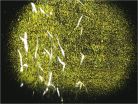(Press-News.org) CAMBRIDGE, MA -- MIT engineers have devised a way to rapidly test hundreds of different drug-delivery vehicles in living animals, making it easier to discover promising new ways to deliver a class of drugs called biologics, which includes antibodies, peptides, RNA, and DNA, to human patients.
In a study appearing in the journal Integrative Biology, the researchers used this technology to identify materials that can efficiently deliver RNA to zebrafish and also to rodents. This type of high-speed screen could help overcome one of the major bottlenecks in developing disease treatments based on biologics: It is challenging to find safe and effective ways to deliver them.
"Biologics is the fastest growing field in biotech, because it gives you the ability to do highly predictive designs with unique targeting capabilities," says senior author Mehmet Fatih Yanik, an associate professor of electrical engineering and computer science and biological engineering. "However, delivery of biologics to diseased tissues is challenging, because they are significantly larger and more complex than conventional drugs."
"By combining this work with our previously published high-throughput screening system, we are able to create a drug-discovery pipeline with efficiency we had never imagined before," adds Tsung-Yao Chang, a recent MIT PhD recipient and one of the paper's lead authors.
Peng Shi, a former MIT postdoc who is now an assistant professor at the University of Hong Kong, is the paper's other lead author.
Fish on the Fly
Zebrafish are commonly used to model human diseases, in part because their larvae are transparent, making it easy to see the effects of genetic mutations or drugs.
In 2010, Yanik's team developed a technology for rapidly moving zebrafish larvae to an imaging platform, orienting them correctly, and imaging them. This kind of automated system makes it possible to do large-scale studies because analyzing each larva takes less than 20 seconds, compared with the several minutes it would take for a scientist to evaluate the larvae by hand.
For this study, Yanik's team developed a new technology to inject RNA carried by nanoparticles called lipidoids, previously designed by Daniel Anderson, an associate professor of chemical engineering, member of the Koch Institute for Integrative Cancer Research and Institute for Medical Engineering and Science, and an author of the new paper. These fatty molecules have shown promise as delivery vehicles for RNA interference, a process that allows disease-causing genes to be turned off with small strands of RNA.
Yanik's group tested about 100 lipidoids that had not performed well in tests of RNA delivery in cells grown in a lab dish. They designed each lipidoid to carry RNA expressing a fluorescent protein, allowing them to easily track RNA delivery, and injected the lipidoids into the spinal fluid of the zebrafish.
To automate that process, the zebrafish were oriented either laterally or dorsally once they arrived on the viewing platform. Once the larvae were properly aligned, they were immobilized by a hydrogel. Then, the lipidoid-RNA complex was automatically injected, guided by a computer vision algorithm. The system can be adapted to target any organ, and the process takes about 14 seconds per fish.
A few hours after injection, the researchers imaged the zebrafish to see if they displayed any fluorescent protein in the brain, indicating whether the RNA successfully entered the brain tissue, was taken up by the cells, and expressed the desired protein.
The researchers found that several lipidoids that had not performed well in cultured cells did deliver RNA efficiently in the zebrafish model. They next tested six randomly selected best- and worst-performing lipidoids in rats and found that the correlation between performance in rats and in zebrafish was 97 percent, suggesting that zebrafish are a good model for predicting drug-delivery success in mammals.
"The ability to identify useful drug delivery nanoparticles using this miniaturized system holds great potential for accelerating our discovery process," Anderson says.
"The lipidoid material screen is just an example demonstrated in this article; a similar strategy can be readily extended to other libraries or other organ systems," Peng adds.
New Leads
The researchers are now using what they learned about the most successful lipidoids identified in this study to try to design even better possibilities. "If we can pick up certain design features from the screens, it can guide us to design larger combinatorial libraries based on these leads," Yanik says.
Yanik's lab is currently using this technology to find delivery vehicles that can carry biologics across the blood-brain barrier — a very selective barrier that makes it difficult for drugs or other large molecules to enter the brain through the bloodstream.
INFORMATION:
The research was funded by the National Institutes of Health, the Packard Award in Science and Engineering, Sanofi Pharmaceuticals, Foxconn Technology Group, and the Hertz Foundation.
Written by Anne Trafton, MIT News Office
High-speed drug screen
2014-09-30
ELSE PRESS RELEASES FROM THIS DATE:
US military making progress reducing stigma tied to seeking help for mental illness
2014-09-30
The U.S. Department of Defense has made progress in reducing the stigma associated with seeking help for mental illnesses such as depression and post-traumatic stress disorder, but more improvement is still needed, according to a new RAND Corporation study.
Despite efforts of both the Defense Department and the Veterans Health Administration to enhance mental health services, many service members still do not seek needed care for mental health problems. Defense officials have made a concerted effort to promote treatment as a way to reduce stigma, according to the study. ...
Laser-guided sea monkeys show how zooplankton migrations may affect global ocean currents
2014-09-30
WASHINGTON, D.C., September 30, 2014--Sea monkeys have captured the popular attention of both children and aquarium hobbyists because of their easily observable life cycle -- sold as dehydrated eggs, these tiny brine shrimp readily hatch, develop and mate given little more than a tank of salt water.
Physicists, though, are interested in a shorter-term pattern: Like other zooplankton, brine shrimp vertically migrate in large groups in response to changing light conditions, coming closer to the surface at night and retreating deeper during the day.
Two researchers at ...
Taking thin films to the extreme
2014-09-30
WASHINGTON D.C., September 30, 2014 – Applying a well-known optical phenomenon called thin-film interference, a group of researchers at Harvard University has demonstrated the ability to "paint" ultra-thin coatings onto a rough surface -- work that holds promise for making future, flexible electronic devices, creating advanced solar cells and detailing the sides of next-gen rocket ships and spacecraft with extremely lightweight decorative logos.
When light passes through oil in water, it becomes iridescent, revealing a myriad of colors that glisten and shift along with ...
Unexpected new mechanism reveals how molecules become trapped in ice
2014-09-30
WASHINGTON D.C., Sept. 30, 2014 – Ice is ubiquitous in nature—found within terrestrial and astrophysical environments alike—and contains many atoms and molecules trapped inside it. For example, ice beneath the world's oceans hosts a vast reservoir of greenhouse gases, which if released would have a profound effect on climate change.
On the earth's surface, seasonal ice and permafrost-covered regions represent a vast reservoir for the collection, concentration and release of environmental and trace gases—encompassing national security concerns about the persistence and ...
Breakthrough study discovers 6 changing faces of 'global killer' bacteria
2014-09-30
Every ten seconds a human being dies from pneumococcus infection making it the leading cause of serious illness across the globe
Research discovers six unique states of pneumococcus
Knowledge of these six characteristics can help in development of tailored vaccines
Every ten seconds a human being dies from Streptococcus pneumoniae infection, also known as pneumococcus, making it a leading global killer.
An interdisciplinary team of researchers from the University of Leicester in collaboration with international experts have unlocked a genetic switch controlling ...
Americans undergo colonoscopies too often, study finds
2014-09-30
Colonoscopies are a very valuable procedure by which to screen for the presence of colorectal cancer. However, it seems that healthy Americans who do undergo this sometimes uncomfortable examination often have repeat screenings long before they actually should. Gina Kruse of Massachusetts General Hospital in the US and colleagues advise that endoscopists stick to the national guidelines more closely. Their findings appear in the Journal of General Internal Medicine, published by Springer.
Current national guidelines strongly recommend that adults aged 50 and older should ...
Longitudinal report shows challenging reality of ageing with an intellectual disability
2014-09-30
Dublin, Ireland, September 30th, 2014 – A new report launched today by the Intellectual Disability Supplement to TILDA (The Irish Longitudinal Study on Ageing) conducted by academics from the School of Nursing and Midwifery, Trinity College Dublin, Ireland, has highlighted the serious, complex and unique health and social challenges facing Ireland's intellectual disability population.
The IDS-TILDA study is the first study of its kind in Europe and the only one in the world with the ability to compare the ageing of people with intellectual disability directly with the ...
Contaminated water linked to pregnancy complications, BU study finds
2014-09-30
Prenatal exposure to tetrachloroethylene (PCE) in drinking water may increase the risk of stillbirth and placental abruption, according to a new study led by a Boston University School of Public Health researcher.
The study, published in the journal Environmental Health, compared 1,091 PCE-exposed pregnancies and 1,019 unexposed pregnancies among 1,766 women in Cape Cod, Ma., where water was contaminated in the late 1960s to the early 1980s by the installation of vinyl-lined asbestos cement pipes. PCE exposure was estimated using water-distribution system modeling software. ...
NEJM: Crizotinib effective in Phase 1 trial against ROS1 lung cancer
2014-09-30
The New England Journal of Medicine reports positive results of a phase 1 clinical trial of the drug crizotinib against the subset of lung cancer marked by rearrangement of the gene ROS1. In this multi-center study of 50 patients with advanced non-small cell lung cancer testing positive for ROS1 gene rearrangement, the response rate was 72 percent, with 3 complete responses and 33 partial responses. Median progression-free survival – the time it takes for the disease to resume its growth after being slowed by treatment – is estimated at 19.2 months with exactly half of ...
Pollution linked to lethal sea turtle tumors
2014-09-30
DURHAM, N.C. -- Pollution in urban and farm runoff in Hawaii is causing tumors in endangered sea turtles, a new study finds.
The study, published Tuesday in the peer-reviewed open-access journal PeerJ, shows that nitrogen in the runoff ends up in algae that the turtles eat, promoting the formation of tumors on the animals' eyes, flippers and internal organs.
Scientists at Duke University, the University of Hawaii and the National Oceanic and Atmospheric Administration (NOAA) conducted the study to better understand the causes behind the tumor-forming disease Fibropapillomatosis, ...



